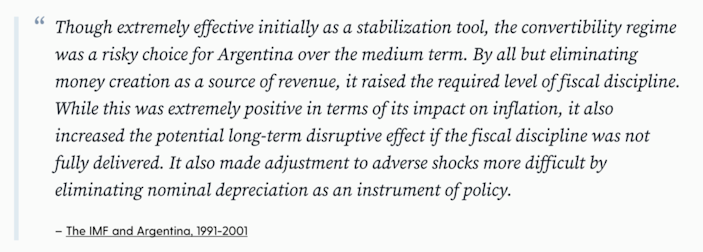Argentina: How Fiat Policies Ruined a Once Prosperous Nation
If Argentina embraces Bitcoin, perhaps it can start to resemble the prosperous nation it once was and its people can finally experience something they haven’t felt in a long time — hope.
Swan Private Insight Update #30
This report was originally sent to Swan Private clients on December 8th, 2023. Swan Private guides corporations and high net worth individuals globally toward building generational wealth with Bitcoin.
Benefits of Swan Private include:
- Dedicated account rep accessible by text, email, and phone
- Timely market updates (like this one)
- Exclusive monthly research report (Insight) with contributors like Lyn Alden
- Invitation-only live sessions with industry experts (webinars and in-person events)
- Hold Bitcoin directly in your Traditional or Roth IRA
- Access to Swan’s trusted Bitcoin experts for Q&A
Did you know that Argentina was one of the wealthiest nations in the world entering the 20th century?
Blessed with an abundance of natural resources, Argentina’s national output expanded at an average rate of 6-7% annually in the early 1900s, led by exports of wheat, flour, meat, corn, and other agricultural products.
To be an Argentine during this time was synonymous with being wealthy. There was even a common expression, “As rich as an Argentine, ” and more than 3 million immigrants flooded to Argentina in those years in search of “The Argentine Dream.”
It might seem crazy to think today, but back then, immigrants had a serious decision to make: “Should we move to the United States or Argentina?”
By the 1910s, GDP per capita in Argentina was greater than that of France and Germany, reaching 80% of the United States at its peak.
Source: World Bank
But as the chart above illustrates, the two economies diverged significantly in the century to follow.
Whereas the United States became the premier economic superpower of the world, Argentina’s wealth gradually dissipated over the century.
What caused this decline?
The answer, of course, is complex, but it can be distilled down into bad policy decisions and corruption.
The country underwent repeated cycles of economic and political upheavals, including multiple military coups, economic depressions caused by socialist policies, and hyperinflations that prevented it from achieving the promise that once attracted foreigners to its shores.
The graph below beautifully depicts the series of political instability and economic policy errors that contributed to Argentina’s decline.
Source: Rok Spruk
Of course, money printing played a pivotal role in Argentina’s demise. This was never more evident than during the 1980s.
In the early 1980s, Argentina faced a debt crisis, and the price of commodities plummeted. Due to Argentina being an export-driven economy, economic growth stagnated, and its financial markets crashed.
As tax revenues plummeted, the Argentine government did what so many governments in the past had done when they were faced with an economic crisis — it succumbed to the temptation of turning to its central bank to help finance itself by money printing.
The graph below shows Argentina’s government spending as a % of GDP since 1900.
Whenever this ratio exceeded 30%, a new high inflation cycle began. The dotted line represents the fiscal deficit generated by the central bank. In the 1980s, you can see how this spiked.
Source: Cavallo (2013), Ferreres (2010), IMF WEO. The dotted line is the quasi-fiscal deficit generated by the Central Bank
This central bank-financed deficit spending culminated in the Argentine hyperinflation of the 1980s, where inflation soared to nearly 5,000% by 1989. Average annual inflation rates exceeded 100% in the ’70s and ’80s.
Source: INDEC
Whereas only decades before, everyday Argentinians were enjoying respectable living standards, by the late 1980s, an estimated 2 to 9 million residents of Buenos Aires were being fed by soup kitchens.
This ruinous hyperinflation led to drastic changes to Argentina’s policies aimed to circumvent its causes. At this time, Argentina adopted economic policy prescriptions promoted by the International Monetary Fund, dubbed the “Washington Consensus.”
The Washington Consensus consisted of privatizing state-owned enterprises, fiscal austerity measures, removal of trade restrictions, and opening up the economy to foreign investment.
However, Argentina took it a step further to prevent its government from printing money. In 1991, the Convertibility Law was passed, which created a currency board that was charged with fixing the exchange rate at one Argentine peso per U.S. dollar.
This put handcuffs on the government because it required them to keep the number of pesos in circulation backed by an equal amount of dollars in their reserves, eliminating the ability of the central bank to finance the government deficit that caused inflation to spiral out of control. Only when more dollars flowed into the central bank were they allowed to expand the money supply.
This did wonders to stop inflation in its tracks. In the graphic below, one can clearly see the effect that the new currency peg had on the inflation rate after it was initiated.
Source: IMF, International Financial Statistics. Year-on-year change in CPI.
And so, Argentina experienced significant growth in the 1990s with inflation in the rearview mirror, and it became an emerging market darling. As Argentina recovered, it became a poster child for the IMF as an example to the rest of the world of what could happen if a country adopted its Washington Consensus reforms. Around this time, the IMF provided Argentina with multiple loans to implement medium-term structural reforms. As Argentina’s economy grew, the government improved its public image and began to take on debt from foreigners at an extraordinary pace.
It’s important to note that foreign investors at the time viewed the new convertibility system as remarkably effective in keeping Argentina’s inflation down, providing stability to the economy that had been absent for decades. As a result, investors increasingly felt comfortable buying Argentine debt, and the Argentine government had no problem issuing more of it to these willing buyers.
The government felt like they were winning because they could fund their deficits with foreign debt, and Wall Street didn’t mind because it was making an absolute killing underwriting the loans. It is estimated that Wall Street firms reaped nearly $1 billion in fees alone from underwriting Argentine government bonds during the 1991-2001 decade.
Rogelio Frigerio, Argentina’s Secretary of Economic Policy in 1998, was quoted as saying:

All of this is to say that although the currency peg helped eliminate inflation and provide economic stability in the 1990s, it did nothing to stop the government’s fiscal profligacy from continuing, just through a different avenue. This led to a rapidly growing but fragile economy that was susceptible to crisis should an economic downturn transpire.
Argentina’s fixed currency regime had other drawbacks besides enabling the government to binge on foreign debt. One important caveat with a fixed currency peg is that a pegging country must give up its monetary policy autonomy in order to stabilize its local currency and increase trade. This leads to inherent risks when the country experiences deteriorating economic conditions domestically. They are limited in their tools to both protect the peg and respond to domestic economic shocks.
By adhering to a strict currency peg, Argentina gave up its monetary sovereignty. So when the Asian Currency and Russian Financial crises unfolded in 1997 and 1998 respectively, causing a contagion event across the globe, Argentina found itself in an extremely vulnerable position.
Argentina was up to its ears in debt with rapidly slowing growth and couldn’t control its own currency exchange rate. It didn’t take long for foreign investors to begin withdrawing their capital in droves as they feared that Argentina would not be able to service its debts.
Source: IMF, International Financial Statistics.
This led to a full-blown economic, banking, and political crisis culminating in the IMF refusing to disburse funds to the nation. In the end, Argentina abandoned the currency peg, froze banking deposits, and defaulted on its $141 billion in foreign debt. It was the largest sovereign default in history at the time.
The IMF touched on the toxic mix of a fixed currency regime and poor fiscal discipline and the role these factors played in Argentina’s collapse:

Furthermore, in a rare admission of culpability, the IMF touched on its own failures in ignoring the building up of economic imbalances while continuously leveraging the Argentine economy, stating:

After Argentina abandoned the dollar peg, the peso went into an absolute freefall, depreciating 50% in a matter of days.
Source: Thomson Financiel Datastream
In the end, it was the Argentine people who suffered. The unemployment rate spiked, and Argentina went into a severe economic depression. Immediately after the default, many Argentines saw the writing on the wall and began dumping their pesos and withdrawing dollars from local banks.
To end the bank run, the government enacted a new law that restricted Argentinians to withdrawing a maximum of 300 dollars per week. This bank deposit freeze was nicknamed Corralito, which, when translated to English, means “child’s playpen” because Argentines felt like the government was treating them like children by not allowing them access to their own money.
At the same time that Corralito was being enforced, the government began swapping all the US dollars in Argentinian bank accounts with pesos. This was because the foreign debt the government needed to pay off was denominated in dollars, and the government was no longer finding it so easy to raise capital in the market during the crisis.
This non-consensual currency swap resulted in Argentinians losing about 75% of their savings a mere two months after the peg was abandoned.
In the end, pegging the peso to the dollar only led fiscal excesses to grow and contributed to more instability and a greater crisis down the road. When we fast forward to today, the country faces problems similar to those that led to the currency peg in 1991. Will they experience the same catastrophic results if they go down a path of dollarization today, as promised/espoused by the newly elected president, Javier Milei?
Since the Argentina Economic Crisis of 2001, Argentina does not seem to have learned from its past mistakes. Coming out of the deep recession, Argentina has experienced political instability, and the fiscal mismanagement has only continued.
Over the last decade, the government has consistently run massive fiscal deficits financed by its central bank.
Source: Government data
Once again, today, government spending makes up more than 30% of Argentina’s GDP, historically a threshold that preceded hyperinflationary events.
Sources: OJF — Orlando J Ferreres & Asociados (public spending); Casa Rosada (presidential terms)
As a result of this spending, Argentina has seen its growth increase, but so too has its inflation. Inflation in Argentina has now hit its highest levels since 1991.
Note: Numbers based on several series data, the compilation of which has adjusted over time. Some data missing for 2015-2016 Source: INDEC
As a result of the inflation, the government has taken several measures. It has been draining its central bank reserves to try to prop up the peso, performed an overnight devaluation of 18% in August 2023, and maintained strict capital controls.
After the devaluation, the gap between the official dollar exchange rate and the black market dollar exchange rate widened to the widest level in 30 years.
Source: Bloomberg
It’s no surprise that Argentinians are increasingly pulling their dollars out of Argentina and storing them abroad. After all, many have seen how this story ends, and they don’t want to find themselves frozen out of their bank deposits again if things take an even greater turn for the worse.
The amount of deposits held abroad by Argentinians dwarfs other countries’. These people do not trust their government, and it’s not hard to see why.
Source: Institute of International Finance
Inflation is only part of the problem, too. Argentina finds itself in a mountain of debt due to many years of poor fiscal policy.
Argentina received the largest loan in IMF history in 2018 to the tune of $57 billion, only to default on it just two years later in 2020. This was the ninth sovereign default in its history.
Since then, the IMF has bailed out Argentina once again with another loan of $45 billion. Today, Argentina is currently the IMF’s top debtor by far.
Source: Institute of International Finance
So this is where Argentina now finds itself — triple-digit inflation, a debt-to-GDP ratio of about 90%, and one in four Argentines currently living in poverty.
All this led to the election of President Javier Milei, whose campaign ran on promises to end the fiscal profligacy, shutter the central bank, and dollarize the economy. But as we have seen from history, this may not be a fix-all solution for Argentina.
Although Milei wants to bring change to Argentina, he is inheriting a mess of an economy. This is why one of the first things Milei has done since he took office is meet with the IMF to discuss terms to roll over Argentina’s debt and avoid another default and potential hyperinflationary event.

Source: Institute of International Finance
Ultimately, President Milei is beholden to its lender (IMF) when it comes to his economic plans, and if the IMF is to accept his agendas, they will undoubtedly be asking for something in return. If the IMF decides to withhold the disbursement of funds, this would prove catastrophic to the highly leveraged country’s economic outlook.
This was never more evident than when Argentina last was given a $45 billion bailout from the IMF. A notable provision in that bailout revolved around cryptocurrencies.
As part of the bailout, Argentina agreed to an IMF-mandated policy that prevents any bank from doing business using cryptocurrencies on Argentine soil.

Source: Coindesk
The provision read, “To further safeguard financial stability, we are taking important steps to discourage the use of cryptocurrencies with a view to preventing money laundering, informality, and disintermediation.”
President Milei has publicly spoken positively about Bitcoin, leading many to label him a pro-Bitcoin candidate, but he will likely find it very challenging to openly support Bitcoin in his presidency due to his country’s dependence on the IMF.
Typically, governments tend to enact stricter capital controls in the face of inflation.
They do this to prevent their citizenry from dumping the inflating local currency, worsening the inflationary crisis. If Milei decides to clamp down on alternative forms of money like Bitcoin to protect the falling peso, he would likely be doing his people a disservice. (This would require him to break his promise to close the central bank and dollarize the economy first.)
Already, Argentina has the world’s 15th highest cryptocurrency adoption rate according to a recent report from Chainalysis. Bitcoin offers a way for the people of Argentina to protect themselves against a government that has mismanaged its economy for decades. On top of being a money that is resistant to inflation, Bitcoin also allows individuals to hold their wealth outside of the banking industry/regime. This will likely resonate for Argentines, given the fresh memory of having their bank accounts frozen.
President Milei wants to push for dollarization to fix the economic crisis that his country is currently engulfed in, but history shows us that this is no silver bullet.
Dollarization may help bring down inflation, but it won’t fix the debt problem or the continuation of poor policy decisions. In addition, in that dollarization process, Milei would be giving up his country’s monetary sovereignty to a foreign country.
What he should consider is adopting a money that is controlled by no one, that can’t be inflated, and that can allow his people to save and build for their future. El Salvador’s Nayib Bukele has shown what can happen to a country when it embraces Bitcoin. Since making Bitcoin legal tender, El Salvador has been experiencing one of the highest growth rates in Latin America and is paying down its debts rather than accumulating more.
While pro-Bitcoin legislation in Argentina is probably a pipedream at this point, a more reasonable hope is that President Milei does not actively prevent Bitcoin’s adoption within his borders as he attempts to right the ship of Argentina. He has an uphill battle ahead of him. But if he can embrace a new monetary technology, perhaps Argentina will start to resemble the prosperous nation it once was long ago, and its people can finally experience something they haven’t felt in a long time — hope.
Swan IRA — Real Bitcoin, No Taxes*
Hold your IRA with the most trusted name in Bitcoin.
Sam Callahan is the Lead Analyst at Swan Bitcoin. He graduated from Indiana University with degrees in Biology and Physics before turning his attention towards the markets. He writes the popular “Running the Numbers” section in the monthly Swan Private Insight Report. Sam’s analysis is frequently shared across social media, and he’s been a guest on popular podcasts such as The Investor’s Podcast and the Stephan Livera Podcast.
More from Swan Signal Blog
Thoughts on Bitcoin from the Swan team and friends.


Running the Numbers: How Fiat Pushed the American Dream Away from Millennials
By Sam Callahan
Bitcoin symbolizes hope for a generation who increasingly feel as though their futures have been stolen from them by the traditional fiat system.


Best Bitcoin ETF Fees: Lowest to Highest (May 2024)

By Matt Ruby
In this guide, we analyze and present the top 10 Bitcoin ETFs with the lowest fees for cost-effective investing.


Privacy, Executive Order 6102 & Bitcoin

By Steven Lubka
Let’s keep pushing forward for the future we want to see, one in which both the price of Bitcoin and global freedom can go up together.
